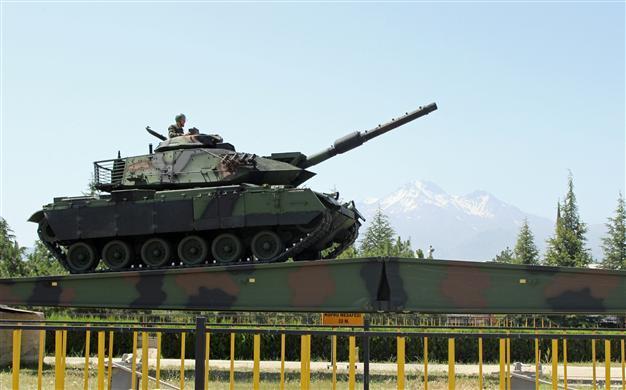Turkey could double its arms spending by 2018
Burak Bekdil ISTANBUL – Hürriyet Daily News

Turkey’s current defense procurement spending is around 1.25 percent of its $800-billion GDP, but defense officials say it should be at least doubled to 2.5 percent of GDP. AA Photo
The world’s most enduring security organization, NATO, which Turkey is a member of, is facing several conventional challenges as its combat mission in Afghanistan comes to a close.Transatlantic austerity has sparked major cuts in defense budgets, pruning allied conventional force and operational capabilities.
Renewing/modernizing assets has visibly slowed down, while focus has shifted to out-of-area deployment.
Security analysts agree that post-Afghanistan NATO may see a shift of focus toward conventional force and steps for a retreat from a security understanding to a defense understanding. The adjustment of new members, however, is progressing at a slow pace.
There are emerging technologies and threats, including the risk of disruptive technologies that may enable individuals or small groups to use force in ways previously reserved for states. There are also shifting demographics, as aging populations entail a diminishing recruiting pool for NATO armies.
Furthermore, there are the rising powers in Asia and Eurasia and their future trajectories; Middle East and Africa are emerging as potential regions where transatlantic interests may be further at stake and Asian nations may wish to play a larger role.
NATO’s European members spend a combined 180 billion euros, second largest after the United States; but the alliance is not sure how best to use this more efficiently with help from modern IT.
Meanwhile, a paradigm shift from deterrence toward prevention and resilience constitutes an enormous challenge, as states grapple with how to internalize a policy that certain threats cannot be prevented through deterrence.
Against this backdrop, more and more defense officials in Ankara remind one of what is known in NATO circles as “Noah’s rule”: Predicting rain does not count, building arks does.
Turkey typically spent around $4 billion a year for new weapons systems and upgrades in the last decade, but the country’s rapidly growing economy, now the world’s 17th biggest, and a governmental commitment to meet procurement goals by 2018 may double that amount, and more than double by 2023.
Turkey’s defense spending is almost flat at around $10 billion a year, or about 1.25 percent of its gross domestic product (GDP), which is now at around $800 billion.
A top security aide to Prime Minister Recep Tayyip Erdogan has said Turkey’s defense spending is less than the NATO requirements, and much less than what a country like Turkey actually needs. “Turkey faces multiple conventional and asymmetrical threats and it would be more convenient if it spent 2 to 2.5 percent on defense,” he said.
NATO leaders have demanded that members spend at least 2 percent of their GDP on defense, but several have struggled to meet that threshold. Currently, few European countries are meeting that benchmark. By way of comparison, Russia spends 4.5 percent of its GDP on defense.
“Economic crisis has shrunk defense spending. Only five or six member nations have reached the 2 percent benchmark,” Timo Koster, director for defense policy and planning at the NATO headquarters, recently told a conference in Ankara.
If the Turkish economy grows by an average 4 percent, Turkey’s national income will rise to $936 billion by the end of 2018. If Turkey by then spends 2 percent of its income on defense, this will mean an annual defense budget of $18.7 billion; and if it spends 2.5 percent on defense, its defense budget would reach as high as $23.4 billion.
As Turkey spends about 40 percent of its defense budget on new equipment and upgrading existing systems, its procurement budget by the end of 2018 could reach nearly $7.5 billion provided that the economy grows at an annual 4 percent and the government decides to reach the NATO benchmark. If it expends 2.5 percent on the military, this figure will reach nearly $9.5 billion.
According to the prime minister’s aide, Turkey’s geostrategic position requires it to spend around $20 billion on defense (and $8 billion on procurement).
Ankara has ambitions to celebrate the republic’s centennial in 2023 with dozens of high-profile armament programs they hope will have been successfully concluded by then.
A list of ongoing and announced programs highlights nearly $70 billion worth of spending until 2023, excluding relatively small programs and others the government may launch in the meantime.
For instance, Turkey will spend $16 billion for 100 F-35 new-generation fighters and $4.5 billion to upgrades its fleet of F-16s. The government will have to allocate $10 billion to develop what will become the first ever indigenous Turkish fighter, dubbed the TF-X. Its production will likely cost another $20 billion. If everything goes as planned, Turkey’s fighter budget will be around $50 billion in the next 10 years.
Other big shots include $1 billion for a landing dock platform; $3.5 billion for utility helicopters; $2.5 billion for a planned indigenous, new-generation main battle tank, the Altay; $1 billion for indigenous satellites; $1 billion for a satellite launching center; $3.5 billion for a long-range air and anti-missile defense system; $2.4 billion for aerial warning and control aircraft; $4 billion for new submarines; $2.5 billion for corvettes under the MILGEM program; $1 billion for locally-developed frigates; $3 billion for attack helicopters; $1.5 billion for the local development of helicopters; $1 billion for new armored vehicles; $1.5 billion for the A400M heavy lift aircraft; $750 million for the locally developed basic trainer, the Hürkuş; $1 billion for electronic warfare systems; $1 billion for drones and electro optical systems; and an unknown number of billions for a locally developed infantry rifle.
This list excludes smaller programs, upgrades and maintenance.
















